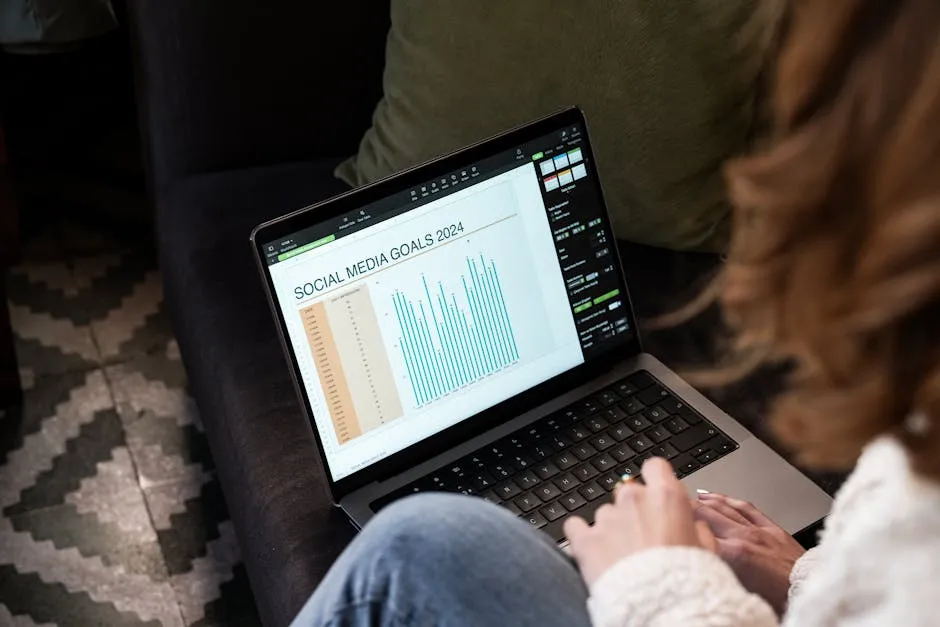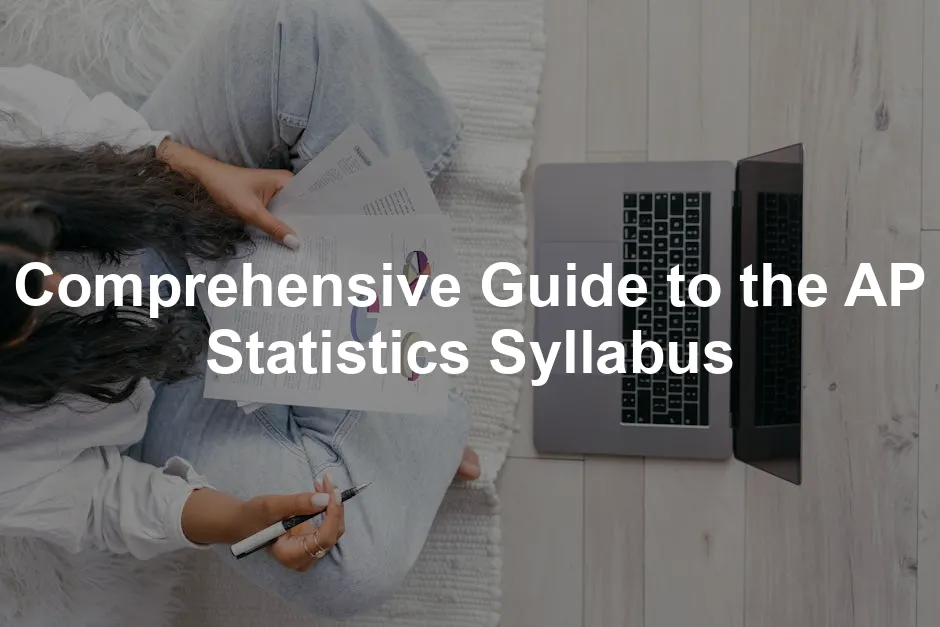Introduction
AP Statistics is not just a class; it’s a statistical adventure! This course introduces high school students to the world of statistics, equipping them with essential tools for collecting, analyzing, and interpreting data. It’s designed to mirror a college-level course, making it a valuable asset in today’s data-driven age.
Understanding the syllabus is crucial. For students, it sets clear expectations and helps plan their study strategies. Parents will appreciate knowing what their children are learning. Meanwhile, teachers can utilize the syllabus to craft engaging lessons that resonate with students.
In this guide, we’ll unpack the AP Statistics syllabus. We’ll explore the course structure, content areas, skills developed, and strategies for exam preparation. By the end, you’ll have a comprehensive understanding of what to expect from this exciting and challenging course.

Understanding the AP Statistics Course Framework
Overview of the Course
The AP Statistics course aims to cultivate a deep understanding of statistical concepts and methodologies. Students will engage with data through technology, problem-solving, and writing. The course covers four major themes: exploratory analysis, planning and conducting studies, probability, and statistical inference. This blend of theory and practical application prepares students for success in various fields, including data science, economics, and social sciences.
To enhance your learning experience, consider using a comprehensive AP Statistics Prep Book. It covers all the essential topics and provides practice exams to help solidify your understanding.
Course Structure
The AP Statistics course is organized into nine units, each focusing on different aspects of statistics. This structure allows for flexibility in teaching methods. Some educators may choose a traditional approach, while others might opt for inquiry-based learning, encouraging students to ask questions and seek answers through statistical exploration.
Here’s a brief breakdown of the units:
- Exploring One-Variable Data: Understanding data variation and representation.
- Exploring Two-Variable Data: Analyzing relationships between two variables.
- Collecting Data: Emphasizing study design and sampling methods.
- Probability, Random Variables, and Probability Distributions: Fundamental concepts of probability.
- Sampling Distributions: Key for understanding statistical inference.
- Inference for Categorical Data: Proportions: Confidence intervals and hypothesis testing.
- Inference for Quantitative Data: Means: Evaluating population means through statistical methods.
- Inference for Categorical Data: Chi-Square: Analyzing categorical variables.
- Inference for Quantitative Data: Slopes: Exploring regression analysis.
This modular approach keeps students engaged and allows teachers to adapt lessons based on their students’ needs. Each unit builds upon the previous one, ensuring a comprehensive understanding of statistical concepts.
By grasping the AP Statistics syllabus, students can navigate the complexities of data analysis with confidence. This course is not just about crunching numbers; it’s about interpreting the world around us through the lens of statistics.

Detailed Breakdown of the AP Statistics Units
Unit 1: Exploring One-Variable Data
This unit is where the stats party begins! Students learn about variation and representation in data. They tackle concepts such as measures of center (mean, median) and spread (range, interquartile range). It’s all about understanding how to describe distributions using graphs and statistics.
A key aspect is recognizing the normal distribution, which is like the statistical equivalent of a rockstar. Why? Because it often shows up in various real-life situations, from test scores to heights. The exam weight for this unit is significant, accounting for 15% to 23% of the total score. Mastering this unit sets the foundation for all statistical adventures ahead!
To aid your studies, grab a Graphing Calculator. It’s a must-have tool for visualizing data and performing calculations efficiently!

Unit 2: Exploring Two-Variable Data
Next up, we move to relationships between two variables. This unit introduces students to scatter plots, correlation, and linear regression. Imagine being a data detective, piecing together clues from bivariate data!
Students learn how to interpret the strength and direction of relationships. They also get cozy with residuals and how to assess whether a linear model fits well. This unit emphasizes the practical applications of these concepts in real-world data analysis, like predicting trends in sales or analyzing survey results. It’s no surprise this unit carries an exam weight of 5% to 7%.
Unit 3: Collecting Data
Data doesn’t just appear out of thin air, folks. It needs a solid plan! In this unit, students dive into sampling methods and study design. They explore how to plan a study and the importance of randomization to avoid bias.
Topics include various data collection methods, such as surveys and experiments. Students also learn about potential pitfalls, like bias in sampling. Understanding these concepts is crucial for conducting valid studies. This unit carries an exam weight of 12% to 15%, highlighting its importance in the overall curriculum.
To assist in your data collection efforts, consider using Statistical Software like SPSS. This can streamline your analysis and make your statistical journey smoother.

Unit 4: Probability, Random Variables, and Probability Distributions
Now, we take a detour into the world of probability. This unit introduces the fundamental concepts of probability theory, including the laws of probability and random events.
Students discover how to deal with random variables and their distributions. They also tackle the binomial and geometric distributions, which help quantify uncertainty. A touch of simulation adds excitement, as students learn to estimate probabilities through hands-on activities. This unit is essential, with an exam weight of 10% to 20%. Understanding probability is like having a secret weapon in the stats toolbox!
For a deeper dive into probability theory, consider the Probability Theory Book. It offers comprehensive coverage of the essential concepts and applications.

Unit 5: Sampling Distributions
Sampling distributions are a cornerstone of statistics. They show us how sample statistics vary from sample to sample. When we take repeated samples from a population, the means of those samples create a distribution. This brings us to the Central Limit Theorem (CLT). It tells us that, regardless of the population’s shape, the distribution of sample means will tend to be normal if the sample size is large enough. Why is this important? Well, it makes statistical inference possible! Understanding sampling distributions helps us make educated guesses about population parameters. It’s like predicting the weather based on past patterns—sometimes accurate, sometimes a bit off, but always based on solid data.

Unit 6: Inference for Categorical Data: Proportions
In this unit, we dive into confidence intervals and hypothesis testing for proportions. Imagine you’re trying to estimate the percentage of students who prefer pizza over tacos for lunch. This unit provides the tools to create confidence intervals around that estimate, giving you a range where the true proportion likely falls. Hypothesis testing comes into play when you want to make claims about proportions. Think of it like a courtroom drama: you start with a null hypothesis (the status quo) and gather evidence (data) to either reject or fail to reject it. This unit carries real-world weight, as businesses use these techniques to make decisions based on customer preferences.
For practice, check out the AP Statistics Exam Practice Tests. These will help you get familiar with the exam format and question styles.

Unit 7: Inference for Quantitative Data: Means
Unit 7 shifts our focus to quantitative data and the means derived from it. Here, we learn to construct confidence intervals and conduct significance tests for population means. Let’s say you want to know if a new study method improves test scores. This unit guides you through the process of collecting data, analyzing it, and interpreting results. The implications are huge—whether you’re a teacher deciding on the effectiveness of new strategies or a business evaluating product quality, understanding how to draw conclusions from means is vital for informed decision-making. For a deeper understanding of statistical inference, check out statistical inference for estimation in data science colorado.
Understanding statistical inference is crucial for making informed decisions based on data analysis. statistical inference for estimation in data science colorado

Unit 8: Inference for Categorical Data: Chi-Square
Welcome to the world of chi-square tests! This unit introduces you to tests used for analyzing categorical data. Chi-square tests help determine if there’s a significant association between two categorical variables. For example, do students’ favorite subjects vary by gender? The chi-square test for independence can answer that! The importance of this unit can’t be overstated. It equips you with the ability to analyze survey data, market research, and more, ensuring that you can make claims based on solid statistical evidence.

Unit 9: Inference for Quantitative Data: Slopes
Finally, we reach regression analysis in Unit 9. This section dives into understanding relationships between variables. You’ll learn about constructing confidence intervals and performing significance tests for regression slopes. This is crucial for making predictions! Imagine you’re predicting future sales based on past trends. This unit shows you how to analyze the relationship between your variables and evaluate the strength of those relationships. The applications are vast—from business forecasting to public health studies, mastering regression can lead to impactful real-world insights.
Skills Developed in AP Statistics
Key Skills Overview
AP Statistics isn’t just about crunching numbers; it’s about cultivating vital skills! Students will learn how to select appropriate statistical methods for collecting and analyzing data. This skill is crucial as it empowers them to make informed decisions based on evidence.
Moreover, learners will delve into data analysis, where they’ll describe patterns, trends, and relationships within datasets. They’ll gain a knack for identifying what the numbers actually mean—beyond just being digits on a page.
Statistical reasoning is another key skill honed during the course. Students will learn to draw logical conclusions from data and justify their claims with solid evidence. This is akin to being a detective, piecing together clues to solve the mystery of the data at hand!

Importance of These Skills
So, why are these skills important? Well, they extend far beyond the classroom. In the real world, data-driven decision-making is more relevant than ever. Whether it’s in business, healthcare, or social sciences, the ability to interpret data can lead to smarter choices and innovative solutions.
Consider data science. This booming field relies heavily on statistical knowledge. Students equipped with strong statistical skills are primed for careers in data analysis, machine learning, and artificial intelligence. They become the architects of algorithms that power today’s technology!
Economics is another area where statistical skills shine. Economists use data to predict market trends, assess risks, and make policy recommendations. The ability to analyze data and interpret results is invaluable in this field.
Even in everyday situations, statistical reasoning plays a role. From evaluating news polls to understanding research findings, the skills learned in AP Statistics help students become discerning consumers of information. They’ll be able to assess the credibility of statistics presented in the media and make informed decisions in their personal and professional lives.
In essence, the skills developed in AP Statistics prepare students for a wide array of career paths while fostering critical thinking. As they learn to navigate the vast sea of data in our world, they become empowered to turn numbers into meaningful insights. This course is not just a stepping stone in education; it’s a launchpad into the future!

Exam Preparation Strategies
Understanding the Exam Format
The AP Statistics exam is like a double-feature film, featuring both multiple-choice questions and free-response sections. The multiple-choice part typically consists of 40 questions that assess a range of statistical concepts. Students must choose the best answer from given options—like picking the perfect topping for a pizza!
The free-response section, on the other hand, allows students to showcase their problem-solving skills. Here, they’ll tackle real-world scenarios and demonstrate their understanding of statistical reasoning. Each question requires more than just an answer; students must explain their thought processes and justify their conclusions.
Understanding the scoring rubric is crucial. Each section is weighted differently, with the multiple-choice questions accounting for 50% of the total score. The free-response section contributes the other 50%. This means that students must prepare thoroughly for both formats to maximize their scores.

Study Tips and Resources
To ace the AP Statistics exam, students should adopt effective study methods. Practice exams are golden! They provide a taste of the real exam experience and help identify areas needing improvement. Additionally, forming study groups can enhance learning. Discussing concepts with peers often leads to those “aha!” moments.
Resources abound for students preparing for the exam. Review books offer concise summaries of key concepts, while online platforms provide practice questions and video tutorials. Websites like Khan Academy and Coursera have dedicated sections for AP Statistics, making it easier than ever to find help.
Don’t forget about AP Classroom! Once students join their class section online, they can access AP Daily videos and assignments tailored to the course. This resource is a game-changer for staying on track with the syllabus.
For additional study aids, consider using Study Flashcards for AP Statistics. They can help reinforce key concepts and make studying more interactive!
In conclusion, with the right strategies and resources, students can approach the AP Statistics exam with confidence. They’ll be ready to tackle any curveball the exam throws their way, armed with skills that will serve them well beyond high school. Happy studying!

Conclusion
Mastering the AP Statistics syllabus is essential for high school students. This course does more than crunch numbers; it empowers students to understand data in our increasingly data-driven world. By grasping key statistical concepts, students gain critical skills that will benefit them in college and beyond.
Engaging actively in the course is crucial. Students should participate in discussions, collaborate on projects, and tackle assignments with enthusiasm. This proactive approach not only enhances understanding but also boosts confidence. The more you engage, the more you learn!
AP Statistics plays a significant role in college readiness. Colleges value students who understand data analysis, as it’s a vital skill across various majors. The ability to interpret data correctly and make data-driven decisions is highly sought after.
Moreover, the skills honed in AP Statistics open doors to numerous career opportunities. Industries like healthcare, finance, marketing, and technology rely heavily on data analysis. Graduates with a strong foundation in statistics are well-positioned to excel in data science, economics, and more.
For a great reference, check out a Statistics for Dummies Book. It’s an excellent resource for students looking to grasp fundamental concepts in a straightforward manner.
In summary, mastering the AP Statistics syllabus is not just about preparing for an exam; it’s about equipping yourself for future success. Dive into the course with curiosity and determination. Your future self will thank you!

FAQs
What are the prerequisites for taking AP Statistics?
To enroll in AP Statistics, students should typically have completed a second-year algebra course. This foundation is crucial for understanding concepts like functions and graphs, which are prevalent throughout the course.
How does scoring work, and what scores are needed for college credit?
The AP Statistics exam is scored on a scale of 1 to 5. Most colleges grant credit for scores of 3 or higher, but this varies by institution. It’s always a good idea to check specific college policies to see what scores are accepted.
What resources can students use to supplement their learning?
Students can utilize various resources, such as review books, online tutorials, and platforms like Khan Academy. Additionally, AP Classroom offers videos and assignments directly related to the syllabus, making it a valuable tool for mastering course content.
How important is the use of technology (calculators, software) in the course?
Technology plays a pivotal role in AP Statistics. Students frequently use graphing calculators, like the TI-83 or TI-84, and software such as Minitab for data analysis. Familiarity with these tools enhances understanding and prepares students for real-world data challenges.
What career paths utilize skills learned in AP Statistics?
The skills developed in AP Statistics are applicable in various fields. Careers in data science, economics, healthcare analytics, marketing research, and even sports analytics often require a solid understanding of statistical principles. Employers value the ability to analyze and interpret data effectively, making these skills extremely marketable.
For those looking to delve deeper into data analysis, consider the Descriptive Statistics Book. It will provide you with the foundational knowledge needed to understand data representation.
Please let us know what you think about our content by leaving a comment down below!
Thank you for reading till here 🙂
All images from Pexels




